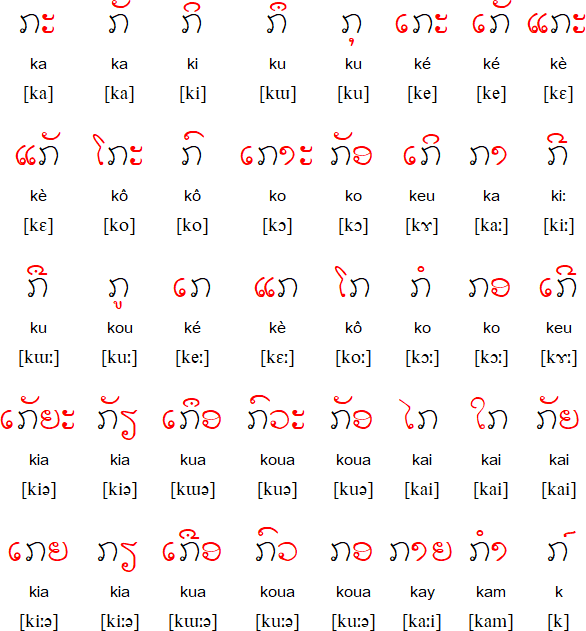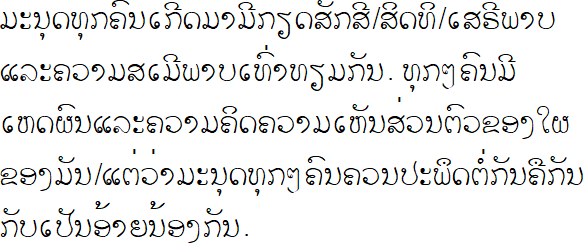Notable features
- Type of writing system: syllabic alphabet / abugida
- Direction of writing: left to right in horizontal lines
- Syllables are based around consonants. Vowels are indicated with diacritics which can appear above, below or around the consonant letters. When they occur on their own or at the beginning of a word, vowels are attached to the glottal stop symbol (the final letter in the third row of consonants).
- Lao is a tonal language with 6 tones. The tone of a syllable is determined by a combination of the class of consonant, the type of syllable (open or closed), the tone marker and the length of the vowel (see below).
- For some consonants there are multiple letters. Originally they represented separate sounds, but over the years the distinction between those sounds was lost and the letters were used instead to indicate tones. Various offical reforms of the Lao script have reduced the number of duplicate consonants.
- There are no spaces between words, instead spaces in a Lao text indicate the end of a clause or sentence.
- Written Lao is based on the dialect of the Lao capital, Vientiene.
- There is no official Latin transliteration system for Lao. In Laos, French-based systems are used and there is considerable variation in spelling, particularly of vowels. In Thailand, the Royal Thai General Transcription is used.
Used to write
Lao (ພາສາລາວ), a Tai-Kadai language spoken by approximately 15 million people in Laos and Thailand. It is closely related to Thai and speakers of Lao are able to understand spoken Thai without too many difficulties. Thai speakers find it more difficult to understand Lao due to lack of exposure to the language. The language family is also known as Kradai, Kra-Dai, Daic or Kadai.Also used to write: Tai Dam, Lave, Eastern Bru, Western Bru, Mong Njua, Iu Mien, Jeh, Kuy, Kataang, Lü, Khmu, Western Katu, Lamet, Hmong Daw, Ngeq, Pacoh, Phunoi, Upper Ta'oih and Lower Ta'oih
Source: http://scriptsource.org/scr/Laoo
Lao alphabet (ອັກສອນລາວ)
The transcription system used here is one used by the British Permanent Committee on Geographical Names (BGN/PCGN).Consonants
Consonants are divided into three classes which help to determine the tone of a syllable (indicated by the numbers below). The sounds represented by some consonants change when they are used at the end of a syllable (indicated by the letters on the right of the slash below). The consonants can all be used at the beginning of a syllable but only some can be used at the end of a syllable.
The consonants in the final row are compounds and conjuncts used as alternatives to the basic consonants.
Vowel diacritics (with k)

Numerals

Tone indication
| Open syllables | Closed syllables * | ||||
| unmarked | short vowel | long vowel | |||
| Class 1 | low | mid | high falling | high | low falling |
| Class 2 | low rising | mid | low falling | high | low falling |
| Class 3 | high | mid | high falling | mid | high falling |
Sample text

Transliteration
Manut thuk khôn kœ̄t māmīkẏat sâk sī, sitthi, sēlī phôp læ khwôm smœ̄ phôp thàw thẏam kân. Thuk thuk khôn mīhēt phôn læ khwômkhit khwôm hian swàn tôw khɔ̄̄ṅ phai khɔ̄ṅ mân, tǣ̀vồ manut thuk thuk khôn khwan paphʉt tàṁ kân khʉ̄ kân kâp pianốy nɔ̄́ṅ kân.
Translation
All human beings are born free and equal in dignity and rights. They are endowed with reason and conscience and should act towards one another in a spirit of brotherhood.(Article 1 of the Universal Declaration of Human Rights)
Links
Information about Laos and the Laotian languagehttp://en.wikipedia.org/wiki/Lao_language
http://www.seasite.niu.edu/lao/laolanguage/lao_language_fp.htm
Online Lao lessons
http://www.seasite.niu.edu/Lao/LaoLanguage/spoken_lao/spokenlao.htm
http://www.laosoftware.com
http://fsi-language-courses.org/Content.php?page=Lao
Lao phrases
http://wikitravel.org/en/Lao_phrasebook
http://www.phrasebook.thai-isan-lao.com
http://laos411.com/language/
Online Lao dictionaries
http://www.sealang.net/lao/dictionary.htm
http://glosbe.com/lo/en/
http://sengphachanh.webege.com/eng2lao.html
http://laodictionary.net
Free Lao fonts
http://www.wazu.jp/gallery/Fonts_Lao.html
http://www.laoscript.net/downloads/
http://www.seasite.niu.edu/seasite.htm#download
Online Lao news and radio
http://www.rfa.org/lao/









.jpg)
.jpg)

.jpg)





0 comments:
Post a Comment
Note: Only a member of this blog may post a comment.